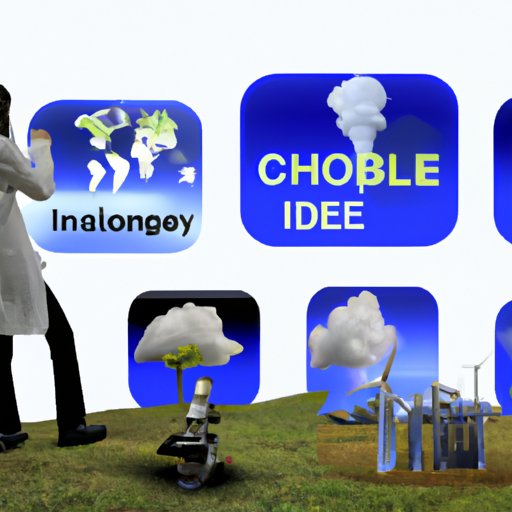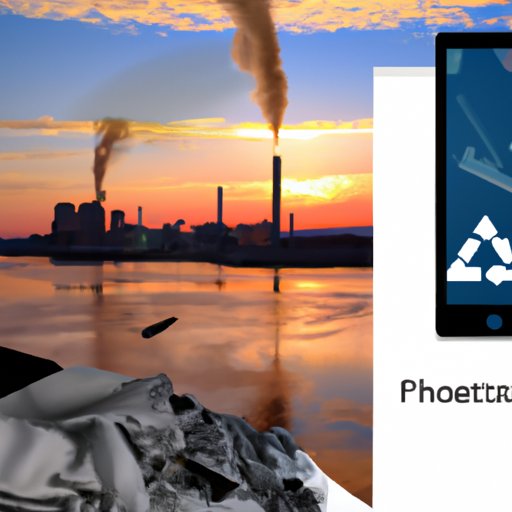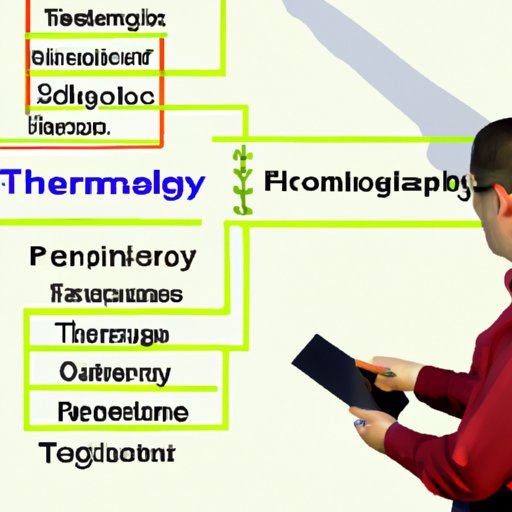Introduction
Technology has long been seen as a force for progress and development, but it is also having an increasingly significant effect on the environment. The term “technology” can be defined as the application of scientific knowledge for practical purposes, and its impact on the environment can range from beneficial to damaging depending on the type of technology used and how it is managed. In this article, we will explore how technology affects the environment, looking at topics such as resource depletion, climate change, pollution and technological advancement.
Analyzing the Impact of Technology on Natural Resources
Natural resources are essential for human life and they play a critical role in the global economy. These resources include fossil fuels, minerals, metals, water and timber, and they are all fundamental to the production of goods and services. Technology has had a huge impact on natural resources, with many of these resources now being extracted more quickly and efficiently than ever before. This has allowed for the rapid growth of industries such as energy and transport, but it has also led to resource depletion.
According to a study by the World Wildlife Fund, “human consumption and population growth have caused the rate of resource extraction to increase dramatically over the past century.” This has resulted in a decrease in the availability of natural resources, leading to environmental problems such as deforestation, air and water pollution, and soil erosion. Additionally, the increased use of technology has led to an increase in the use of synthetic materials, which can be difficult to dispose of safely.
While technology has enabled us to access resources more quickly, there are alternatives available that are much more sustainable. For example, renewable energy sources such as solar, wind and hydropower can be used to meet our energy needs without relying on finite resources like coal or oil. Additionally, recycling and reusing materials can reduce the amount of waste produced and help conserve natural resources.
Examining the Environmental Effects of Technological Advancement
Technological advancement is often seen as a positive force for development, but it can also have a negative impact on the environment. Technology can lead to increased production of goods and services, but it can also result in increased emissions of greenhouse gases and other pollutants. Additionally, technological development can result in land degradation, habitat destruction, and increased demand for natural resources.
The advantages and disadvantages of technological advancement depend on how it is managed and regulated. According to a study published in the journal Nature Climate Change, “well-regulated and managed technology can reduce environmental impacts and provide economic benefits, while poorly managed technology can do the opposite.” Therefore, it is important to ensure that technology is developed and managed in a way that minimizes its environmental impact.
Potential solutions to minimizing environmental damage include developing cleaner technologies, using renewable energy sources, and reducing waste. Additionally, governments can implement policies to encourage the development of green technologies and incentivize businesses to adopt more sustainable practices. By taking these steps, we can ensure that technological advancement does not come at the expense of the environment.
Exploring the Positive and Negative Sides of Technological Development
Technology can have both positive and negative effects on the environment. On the one hand, technology can improve the efficiency of production processes and reduce the need for natural resources. For example, solar panels and wind turbines can provide renewable energy with minimal environmental impact. Additionally, advances in technology can lead to improved waste management systems, which can help reduce pollution.
On the other hand, technology can also have a negative effect on the environment. For example, the burning of fossil fuels for energy can lead to air pollution, and the manufacture of electronic products can produce hazardous waste. Additionally, technological development can lead to the destruction of habitats, as well as the displacement of people and wildlife.

Investigating the Role of Technology in Climate Change
Climate change is one of the most pressing environmental issues of our time, and technology plays an important role in both contributing to and mitigating this problem. The burning of fossil fuels for energy is one of the main causes of climate change, as it releases large amounts of carbon dioxide into the atmosphere. Additionally, technological development can also lead to land-use changes that can affect the climate, such as deforestation and urbanization.
There are a number of strategies that can be used to combat climate change, including reducing emissions from energy production, increasing energy efficiency, and investing in renewable energy sources. Additionally, technologies such as carbon capture and storage can be used to reduce emissions from existing sources. By taking these steps, we can work towards reducing the impact of climate change.

Assessing the Relationship Between Technology and Pollution
Pollution is another environmental issue that is directly linked to technology. Pollutants such as air pollution, water pollution, and plastic waste are all caused by human activity, and technology plays a major role in their production. For example, the burning of fossil fuels for energy produces air pollutants such as carbon dioxide and nitrogen oxides, while the manufacturing of goods can produce hazardous waste such as heavy metals and chemicals.
There are a number of strategies that can be used to reduce pollution, including improving waste management systems, investing in clean energy sources, and reducing consumption. Additionally, technologies such as air filtration systems and water purification systems can be used to reduce air and water pollution. By taking these steps, we can work towards reducing the amount of pollution in the environment.

Evaluating the Benefits and Risks of Technology for the Environment
Technology has both positive and negative effects on the environment, and it is important to evaluate the potential risks and benefits of any new technology before it is developed or implemented. It is also important to consider the long-term implications of any new technology, as some technologies may have positive effects in the short-term but could cause significant harm in the long-term. Additionally, it is important to ensure that any new technology is properly managed and regulated to minimize its environmental impact.
Strategies to mitigate potential risks include conducting environmental impact assessments, implementing regulations to control emissions, and investing in research and development. Additionally, public awareness campaigns can be used to educate people about the potential risks of technology and to encourage them to take action to protect the environment.
Conclusion
In conclusion, technology has both positive and negative effects on the environment. While technological advancement can lead to economic growth and development, it can also have serious environmental consequences if it is not properly managed and regulated. It is important to evaluate the potential risks and benefits of any new technology before it is developed or implemented, and to ensure that it is managed in a way that minimizes its environmental impact. Additionally, strategies such as investing in renewable energy sources and reducing emissions can help to reduce the impacts of technology on the environment.
By understanding the effects of technology on the environment, we can develop strategies to reduce its impacts and ensure that technological development does not come at the expense of the environment. It is up to us to ensure that technology is used responsibly and sustainably, so that we can continue to reap the benefits without causing further harm.
(Note: Is this article not meeting your expectations? Do you have knowledge or insights to share? Unlock new opportunities and expand your reach by joining our authors team. Click Registration to join us and share your expertise with our readers.)
